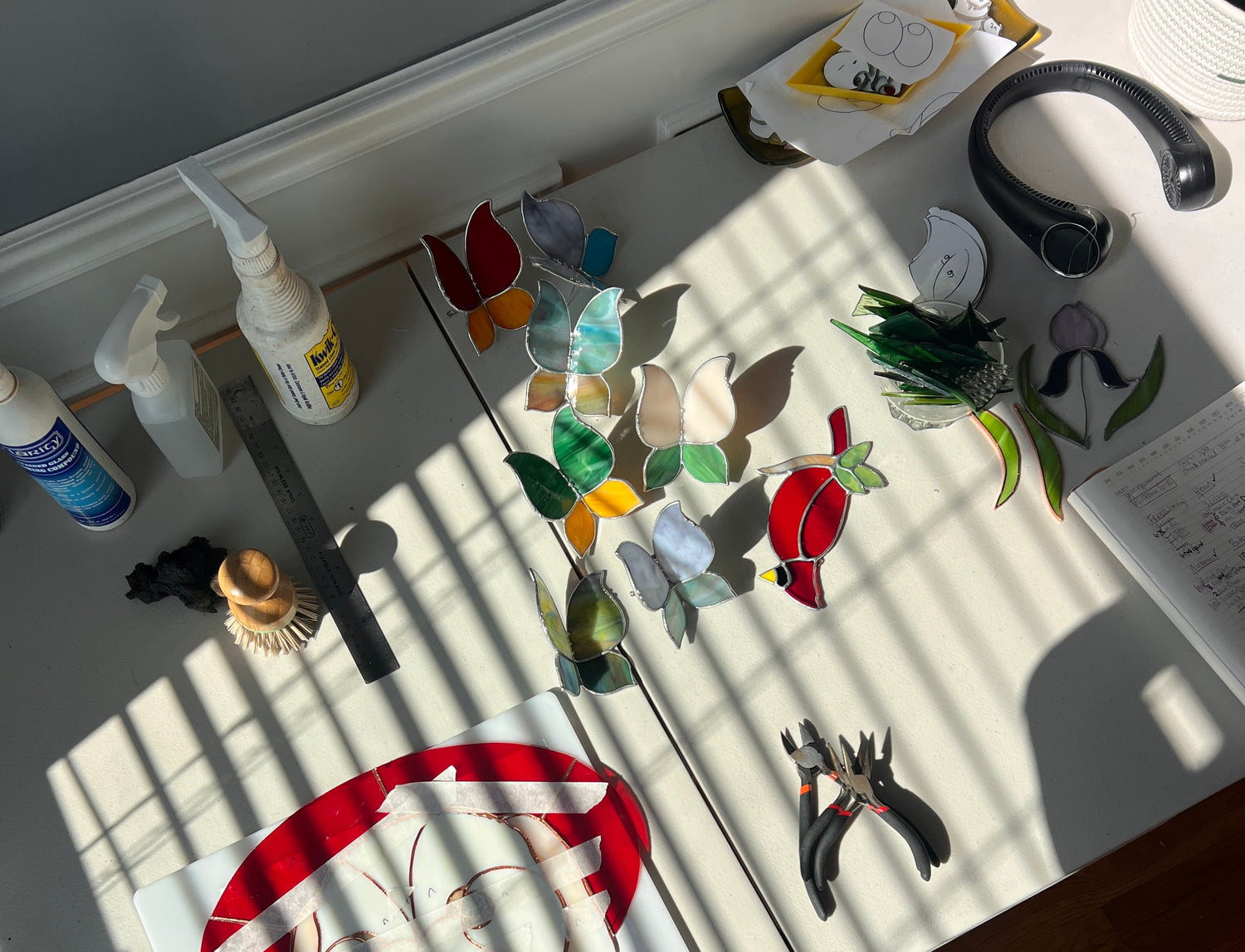
Tools & Patterns
When I first started stained glass, I felt overwhelmed by all the different tools and supplies. Over time, I’ve learned which ones are worth investing in and which ones I use in my studio almost every day.
This page is a collection of the tools and materials I personally use and recommend. If you’re starting your own stained glass journey, these are the essentials that will make your work easier, safer, and more enjoyable.
You can also purchase my original patterns below!
As an Amazon Associate, I earn from qualifying purchases.
Tools & Patterns
🔥 Assembly Tools
-
Copper Foil Tape – For the Tiffany-style method, copper foil is a must. I prefer Edco because it adheres smoothly and holds strong during soldering. Less breakage on curves. I use 3/16 black backed for most projects, but also use 7/32 in black, silver, and copper. I also keep 3/16 in copper and silver on hand. And for fun projects, I break out the scalloped foil!
-
Soldering Iron – A nice quality temperature controlled soldering iron makes all the difference. Hakko FX601 is my go-to for consistent results.
- Anti Fatigue Mat - This set of 2 super cute anti fatigue mats are a lifesaver when I'm on my feet cutting and grinding for hours.
✂️ Cutting Tools
-
Glass Cutter – A sharp, durable glass cutter is the foundation of stained glass work. I use a pistol grip and it is the best! I also dip my scoring tool in a jar filed with cotton swabs soaked in this glass cutting oil.
-
Running Pliers & Grozing Pliers – These two are essential for breaking and shaping glass. I recommend this set which is beginner-friendly and long-lasting.
🎨 Finishing Supplies
- I use TONS of these washable towels for this part of the process. Stock up!
- Engraver - I use this engraving tool to sign my pieces. So important to sign your artwork!
-
Flux & Patina – Flux allows your solder to flow, and patina gives your piece a beautiful finish. I always keep Amerway Tiger's Eye Flux or Classic 100 Gel Flux and Novacan brand for both black patina and copper patina on hand. These Brushes for flux application and crazy enough, toothbrushes for patina!
-
Cleaner – After soldering, it's super important to clean off all of your flux. I use Kwik Clean for every piece and CJ's flux remover in combination with copper patina for a sparkly finish. I use a Bamboo brush to scrub.
- Polish & Wax - This is when elbow grease comes into play. I use Clarity Finishing wax and Sprayaway (always use an ammonia free glass cleaner, never Windex!) to finish the piece.
🛡️ Safety Essentials
-
Working with stained glass means handling sharp glass, lead, and fumes. These safety essentials protect me in the studio and are just as important as the tools themselves:
-
Rubber Gloves – Protect your hands while handling chemicals and patina. I keep these Nitrile gloves stocked.
-
D-Lead Soap – A must for stained glass artists, these disposable wipes help remove lead residue after soldering. [D-Lead Soap + Link]
-
Respirator Mask – Protect your lungs from glass dust and solder fumes. [Respirator Mask + Link]
-
Fume Extractor – Soldering produces fumes that you don’t want to breathe. I literally asked for this Valtcan Solder Fume Extractor for Christmas one year. So important to keep the air in your studio clean. I double up and use this one too.
-
Safety Glasses – Protect your eyes while cutting and soldering. I use Stoggles every time I’m in the studio. I have a couple different colors and styles. Worth the price and they're cute.
-
-
-
Heat-Resistant Gloves – Keep your hands safe from burns with these heat resistant gloves.
- Soldering Surface - This Homasote board is heat resistant and protects your work surface. I have a couple on hand and throw them out when they get
-
+ Miscellaneous
-
Nail Hardener - This may seem random, but pre-stained glass I used to have my nails done all the time. Since they get ruined in the grinding process, I wouldn't have them painted and they were super weak. This nail hardener helps keep my nails strong and shiny!
-
Vinyl Contact Printer Paper - For some designs I like to use this vinyl contact printer paper instead of tracing onto the glass. I've tried lots of contact paper and this on doesn't leave residue on the glass and can be put through the printer.
-
Fish Tank – I put my grinder in a fish tank, on it's side to help contain some of the glass dust that accumulates when grinding.
-
Metal Rods – Lots of uses for these metal rods including plant stakes and frame stands! I have them in ~18 inch Silver and Brass, and also 12 inch Brass.
-
Anti Fatigue Mat - This set of 2 super cute anti fatigue mats are a lifesaver when I'm on my feet cutting and grinding for hours.
✨ Ready to Create?
Here are the tools and materials I personally use in my stained glass studio. If you’re starting your own stained glass journey, these are the ones I recommend.
And if you’re looking for something to make with them, check out my original stained glass patterns below. Each one comes with a hobby and commercial license, so you can create for fun or for profit.
Final Note
Having the right tools makes stained glass more enjoyable and gives you better results. I hope this list helps you feel confident in setting up your own studio.
If you ever make something using my patterns, I’d love to see it. Tag me on Instagram [@swaydesignstudio] so I can see your work!



